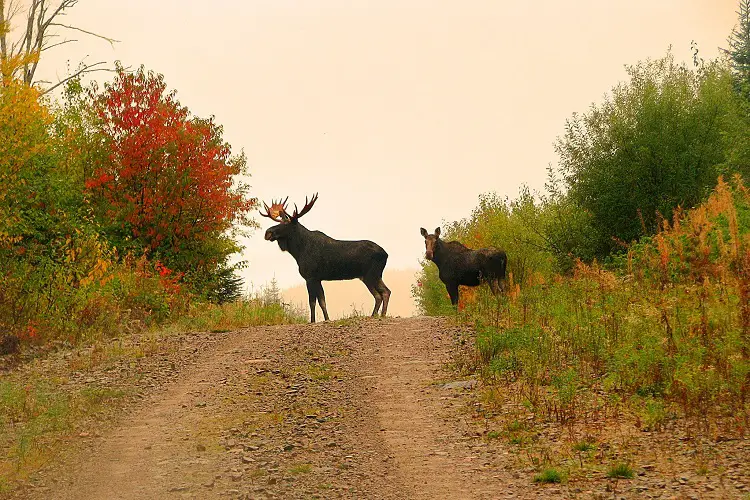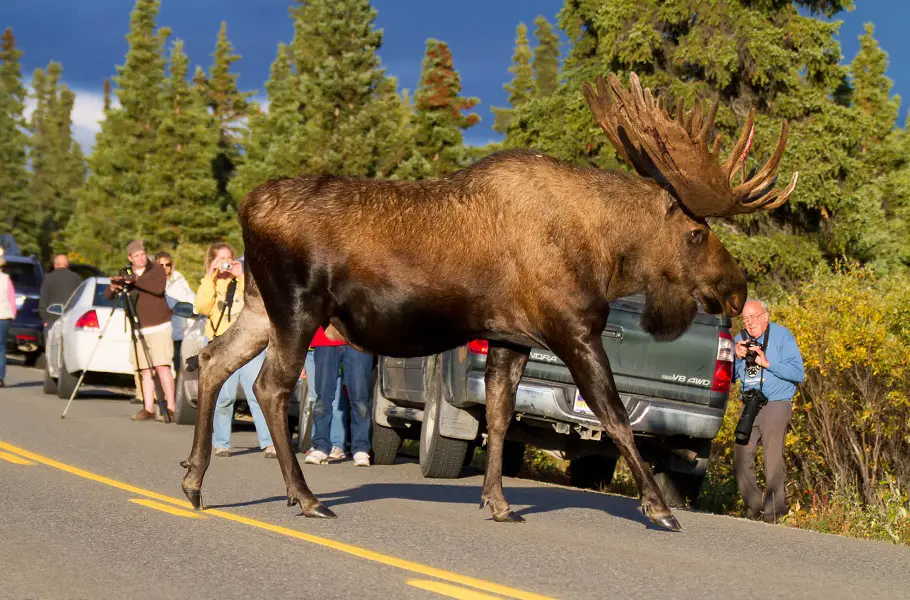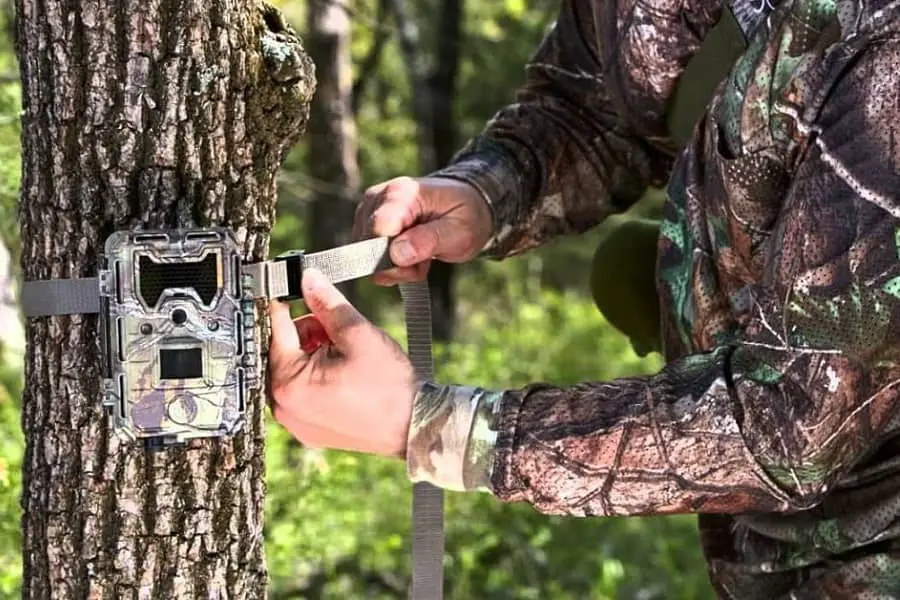From their impressive size to the fact that they can weigh up to 1,800 pounds, there’s no denying that these majestic creatures are some of nature’s most fascinating inhabitants.
But what else do you know about them?
Moose behavior, hunting tips and management strategies all play a part in understanding this animal better.
We’ll also cover interesting facts about moose as well as conservation efforts being taken to protect them. So come on an adventure with us – let’s explore why big is indeed a moose!
What is a Moose?

Moose are the largest members of the deer family and can be found in North America, Europe, and Asia.
They have long legs with a humped back, a large head with an overhanging muzzle, and antlers that can reach up to 6 feet wide. The color of their fur varies from dark brown to almost black.
They have thick fur to protect against predators, long legs with a humped back, a large head with an overhanging muzzle, and antlers that can reach up to 6 feet wide. Their diet consists of leaves, twigs, bark, and aquatic plants.
Physical Characteristics
Moose are typically 4-7 feet tall at the shoulder when standing on all fours. They weigh between 800-1,500 pounds depending on gender and age.
Their coat is made up of two layers; an outer layer which helps keep them warm during cold weather months and an inner layer which keeps them cool during hot summer days.
Moose also have thick fur around their neck area for protection against predators such as wolves or bears.
Habitat and Range
Moose range across most of Canada, Alaska, and northern parts of New England states in the USA as well as some European countries including Norway, Sweden, Finland, and Russia.
Due to hunting pressure reducing populations significantly elsewhere in past centuries since colonization began worldwide by European settlers looking for new lands beyond their own borders hundreds of years ago now, moose are not found many other places outside these regions.
Diet and Feeding Habits
Moose are majestic animals that can be found in a variety of habitats around the world.
They have distinct physical characteristics and behaviors that make them unique among other large mammals.
Moose Behavior
Moose are highly social animals and live in small family groups, usually consisting of a mother and her offspring.
The mother is typically the dominant member of the group, while her calves will stay with her until they reach maturity at around two years old. Moose also form larger herds during winter months when food is scarce.
Breeding habits for moose vary depending on location and climate. In colder climates, mating season occurs from September to October, while in warmer climates it can occur as early as July or August.
During this time males become increasingly aggressive towards one another as they compete for mates. After mating has occurred females will give birth to their young after about 8 months gestation period and then care for them until they reach maturity at 2 years old.
Interactions between humans and moose have been known to be both positive and negative depending on the situation. Moose can be dangerous if provoked or startled, so it is important to keep your distance if you encounter one in the wild.
Many people enjoy observing these majestic creatures from afar without disturbing them too much; given enough space, moose can even become accustomed to human presence over time, making them less likely to attack if approached cautiously by humans who respect their boundaries.
Moose behavior is complex and varied, but understanding their social structure, breeding habits, and interactions with humans can help you to better appreciate these majestic creatures.
Moving on to Moose Hunting and Management, let’s explore the legal status of moose hunting as well as tactics and strategies for managing their populations.
Moose Hunting and Management

Moose Hunting and Management is an important part of preserving the species.
Knowing the legal status, hunting techniques, and population management strategies are essential for responsible hunters.
Legal Status and Regulations
Moose hunting is regulated by state wildlife agencies in North America. Each state has different regulations regarding when and where moose can be hunted, as well as bag limits on how many moose can be taken per season.
It’s important to familiarize yourself with your local laws before heading out into the field to hunt moose.
Hunting Techniques and Tactics
When it comes to hunting moose, there are a few key tactics that you should consider using in order to increase your chances of success.
Scouting ahead of time will help you identify areas where moose may frequent or bed down during certain times of day or night.
Additionally, calling for bulls can be effective if done correctly; however, it’s important not to overcall as this could spook them away from the area altogether.
Lastly, still-hunting (slowly walking through an area while being aware of your surroundings) is also a great way to spot a bull without alerting him of your presence too soon.
Interesting Facts About Moose
Moose are large mammals that can be found in North America, Europe, and Asia.
They have a unique set of adaptations for survival in the wild, including their long legs and wide hooves which help them traverse difficult terrain.
Moose also have thick fur to keep them warm during cold winters and they are excellent swimmers due to their webbed feet.
Adaptations for Survival in the Wild
Moose have several adaptations that make them well-suited for life in the wild.
Their long legs allow them to wade through deep snow or mud with ease while their wide hooves provide stability on slippery surfaces like rocks or logs.
In addition, moose have thick fur coats that protect them from extreme temperatures both hot and cold as well as water-resistant outer layers of hair that helps keep moisture away from their skin.
Unusual Behaviors and Traits
Moose possess some unusual behaviors and traits not seen in other animals such as being able to dive underwater when threatened by predators or swim across large bodies of water with ease thanks to its webbed feet.
Moose are known for having an acute sense of smell which is used to detect potential danger nearby before it can become visible – this trait has helped many moose survive attacks from bears or wolves over time.
The cultural significance of moose varies greatly depending on where you look around the world, but one thing remains consistent: these majestic creatures hold a special place within many cultures’ folklore and mythology due to their size, strength, intelligence, speediness (when needed), adaptability and ability to thrive even under harsh conditions.
It is no surprise why they are so revered by many people all over the world.
Conservation Efforts for Moose
Moose are a large and iconic species of deer found throughout the northern hemisphere.
They are an important part of many ecosystems, but their populations have been declining in recent years due to various threats.
Conservation efforts for moose aim to protect this species from further decline and ensure its continued survival in the wild.
Threats to Moose Populations
The primary threats facing moose populations include habitat loss, climate change, disease, predation by wolves and bears, hunting pressure, vehicle collisions, illegal poaching and over-harvesting.
All of these factors can contribute to population declines if left unchecked.
Conservation Organizations Working To Protect Moose
Several organizations around the world are working hard to conserve moose populations through research projects that focus on understanding how different threats affect them as well as conservation initiatives such as habitat protection and restoration programs.
These organizations also work with local communities to promote sustainable hunting practices that will help maintain healthy moose numbers while providing food security for people living near their habitats.
FAQs

How big is a full size moose?
The size of a full-grown moose can vary depending on the species and location. Generally, adult males can reach heights up to 6 feet at the shoulder and weigh up to 1,800 pounds.
Females are typically smaller than males, reaching an average height of 4-5 feet at the shoulder and weighing between 800-1,200 pounds.
Moose antlers can span up to 6 feet across in some cases. Overall, moose are among the largest mammals in North America with impressive sizes that make them stand out from other wildlife.
How big is a moose compared to a person?
Moose are the largest members of the deer family, and they can be significantly larger than a person.
Adult males typically stand between 5 to 6.5 feet tall at the shoulder and weigh up to 1,800 pounds. Females are usually smaller, standing 4 to 5 feet tall at the shoulder and weighing up to 1,200 pounds.
Moose have long legs that allow them to move quickly through their environment while also providing an impressive reach when browsing for food in trees or bushes.
How big is the biggest moose?
The biggest moose ever recorded was a bull Alaskan-Yukon Moose (Alces alces gigas) shot in September of 2018 near the town of Kotzebue, Alaska. It weighed 1,800 pounds and had an antler spread measuring over 6 feet across.
The animal measured 8 feet tall at the shoulder and 10 feet long from nose to tail. This massive specimen is considered one of the largest moose ever taken by a hunter anywhere in North America.
How big is a moose compared to a car?
A moose is significantly larger than a car. On average, an adult moose stands between 5 and 6 feet tall at the shoulder and can weigh up to 1,500 pounds.
In comparison, a typical sedan car measures around 4 to 5 feet in height and weighs about 3,000 pounds. This size difference makes it clear that a moose is much bigger than any type of car.
Conclusion
From their large size to their unique behavior, moose are an impressive species that can be found in many parts of the world.
Whether you’re interested in hunting them or just learning more about them, it’s clear that “big is a moose” and they are an important part of our natural environment.
Conservation efforts for moose have been successful in some areas, but there is still much work to be done if we want to ensure this species continues to thrive.
With continued research and protection, we can help make sure these majestic creatures remain a part of our planet for generations to come.
Resources:






